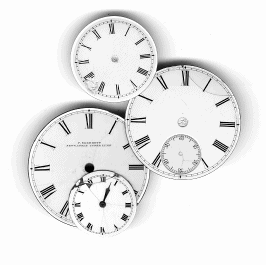Issue
Article
Vol.28 No.3, July 1996
Article
Issue
Issue |
Article |
Vol.28 No.3, July 1996 |
Article |
Issue |

A while back I used to have a workstation on my desk. Click the mouse button on the screen background and you'd get a pop-up menu of options. Due to some quirk of memory, file servers and network, the pop-up menu used to take minutes to appear. I'd go click with my mouse, the hard disk would start to thrash and whirr and eventually a menu would flicker into existence on the screen. Usually I wouldn't be around to see it, I'd have impatiently gone off to wait instead for the photocopier or the coffee machine. In retrospect the term pop-up menu was completely incorrect, a more accurate term would have been a drag-up-painfully-slowly menu.
Menus also feature in La Valade; a restaurant near where I work. You don't have to wait for the menu at all. It's a set meal, so as soon as you sit down they know what you want. However if it's busy you do have to wait a while for the five courses. The funny thing is that the combination of company and atmosphere in a good restaurant means that the waiting is just as good as the eating. In fact it isn't really waiting anymore.
Waiting seems to be a major part of interacting with technology, products and systems are always keeping to the leading edge of what is possible, and often these things are only possible if the system has extra time to do it. Thus the user is always on the waiting end of an egg timer, a piece of relaxing music or a progress bar. It is the technician's job to keep the waiting down to an absolute minimum but it is the user interface designer's job to ensure that the user feels as good as possible while waiting.
The least complex factor in designing for waiting is giving feedback as to the end of the waiting. Many systems do things for users where the activity is invisible, or almost so, and in such cases it is vital to have a clear statement that the task is done.
By coincidence rather than design, our old coffee machine used to signify it had finished by giving a series of gurgling gasps, each one slower than the last. One was never quite sure whether it really was the last gurgle or not. We now have a new machine that is quieter, and instead of gurgling and spluttering it gives a series of sharp beeps when it has finished. The beeps are so severe that for the first week every time the coffee was ready people panicked because they thought that one of the servers had crashed.
Coupled with signaling the end of a process it is also useful to indicate how far in the process the system is (remember the kids in the back seat of the car asking `are we nearly half way yet?' `are we nearly a quarter of the way to being half way yet?'). Systems should give some indication of the length of time a task is expected to take and an indication of how far they are with the task.
Lift design is an area where usability designers have to deal with groups of busy people waiting to do a simple task and in a hurry to do it. The progress of lifts can be simply shown with illuminated numbers but this is not exact feedback as someone on the floor above could also be waiting for the lift to arrive. There are more modern lifts that take this into account and give an estimated time of arrival for the next lift.
However the question still remains; what do you do while you are waiting for the lift? And this is the third area; giving the user something to do while they are waiting.
You could take the approach of the restaurant and ensure that the time waiting for the lift to arrive or the copier to warm up was spent in atmospheric surroundings with music and good company, but this would make interactive technology exorbitantly expensive.
One approach is to combine waiting with tasks where the user has to hang around anyway, for example mounting pinboards or poster boards by the lift. Indeed one company found an extremely cost effective way to stop the employees complaining about the waiting for the antiquated lift system. They simply hung a large mirror up by the lift entrance on each floor. The number of complaints was significantly lowered.
One nice suggestion I have heard recently concerns waiting in the virtual queue for a telephone service. The queue is virtual but the waiting is real enough. The suggestion was that instead of staying put in the phone queue and listening to the recorded voice saying you are number 6 in the queue (which is what happens in the Netherlands), what you do is connect the people in the queue to each other, then they can chat (just like in a real life queue) and, who knows, they may even find the answer to the question they were waiting to ask.
Lon Barfield
Lon Barfield is the author of `The User Interface, Concepts and Design' (Addison Wesley) and is an associate director of General Design ( http://www.design.nl ). He can be contacted at lon@design.nl .
Issue |
Article |
Vol.28 No.3, July 1996 |
Article |
Issue |